Over the years, I've heard it being said repeatedly that some meals are very demanding to make. Someone from my part of Nigeria will quickly agree that you can not make some of our local cuisines without adequate planning. While it may be easy to be spontaneous with some meals, deliberateness is required from shopping to ingredient preparation and cooking of certain foods like the ones I will be sharing in this two part blog post.
I spent a good number of my formative years living with my aunt who was a civil servant. Her official routine started at 8:00Hrs to 16:00Hrs every day and she always made it home too exhausted for any sort of serious task like cooking. I was still a pupil and the most we cooked during workdays was spaghetti, rice, and beans. The hectic meals were relegated to the weekend as they required careful shopping and so much preparation time: something we could only afford during the weekend and public holidays.
Meals like "Ayang Ekpang" (Cocoa yam swallow) and "Efere Abak" (Palm kernel soup) were only made on those resting days. We considered cooking these meals a form of marathon and like every marathon, we finished sometimes too exhausted to enjoy the delicacy we made. Often, the meal was best enjoyed by those who did not partake in its preparation like lucky visitors and family members who would never go through that stress of cooking but enjoy eating this revered native dish.
Despite the long hours it takes to get Ayang Ekpang and Efere Abak ready, I've always enjoyed being a part of the process. Something in me rejoices when I imagine the result my labour of love will produce: a delicate swallow and luscious oily soup. I mean how many persons get to eat the fruit of their labour with such mellow taste?
Plantain leaves were the usual wrap for Ayang Ekpang but that has been replaced over the years with Moi-Moi leaves for ease. The plantain leaf wrapping required the edges of the leaf to be heated lightly to withstand folding and sadly, I did not master that technique before it faded out.
The leaf used in Efere Abak depends on the individual. Atama or Afang leaf, always works for me and on the days I am lucky to get fleshy palm kernels, one can find me smiling from molar to molar 😁. The trick to a creamy, luscious palm kernel soup is to leave the pot open while cooking and cooling. A closed pot will trap steam and distilled steam alters the taste of this soup.
Another weekend is fast approaching, are you going to be intentional about cooking something very time consuming?
Regardless of what your response is, please roll over to the second part of this blog post "Intentional 2" (<<link in bold italics).


Comments
Interesting... didn't know you could use Afang leaf for Efere Abak. I've not had Ayang Ekpang before tho, but I totally love Efere Abak. That soup scent and taste is divine!!😁
ReplyDeleteUsually, Abak soup gets the corresponding prefix or suffix from the type of leaf used. I know at least three types of Efere Abak
DeleteAbak Atama - using Atama leaf
Abak Afang - using Afang leaf
Iwuk Abak - using pumpkin leaf
So long as everything is done correctly, all three taste just as divine.
Post a Comment